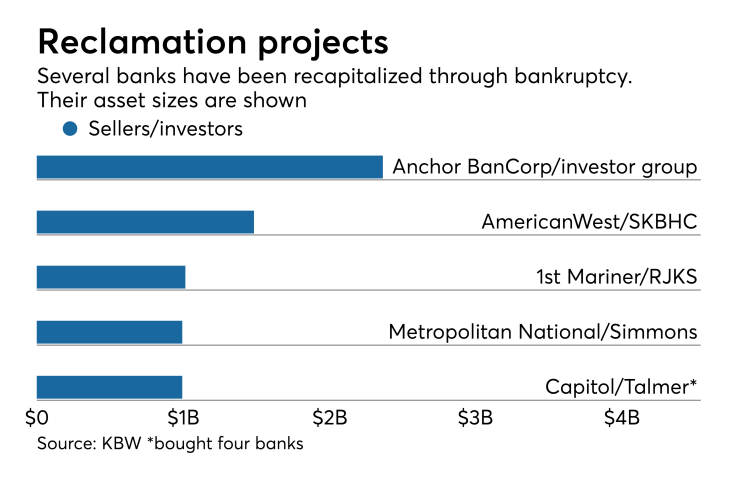The investors who salvaged 1st Mariner Bank had a fair share of difficulties as they handled the institution’s turnaround.
Roughly three years after guiding the Baltimore bank through bankruptcy, the group hopes to reap the benefits from 1st Mariner’s pending sale to Howard Bancorp in Ellicott City, Md. Though the deal isn’t structured as a merger of equals, the terms show that the parties view it more as a partnership than an outright takeover.
A collaborative approach was important to Robert Kunisch, 1st Mariner’s president and CEO and one of the investors responsible for keeping the bank afloat after the financial crisis. Kunisch will become Howard’s president after the deal closes.

“What’s so important to everyone is the culture and the way we look at credit and underwriting and the emphasis we put on relationship banking,” Kunisch said. “Any transaction had to embrace that. Without question, Howard embraces that.”
The sale is another twist in 1st Mariner’s story. The bank struggled for years, losing more than $100 million from 2006 to 2015. Kunisch and
The $1.1 billion-asset Howard, which mulled a bid for 1st Mariner during the bankruptcy, steered clear because of the institution’s size at the time and concerns that a deal could be too dilutive for its own shareholders, said Mary Ann Scully, Howard’s chairman and CEO.
What a difference a few years makes.
The $975 million-asset 1st Mariner, which largely addressed its problem loans, has distanced itself from its previous reliance on mortgages to become a more commercial-focused institution.
The deal also shows that size and scale matter — to a degree. Howard, which will nearly double in size when it buys 1st Mariner, will also have 21 branches in the Baltimore area. But it will also be small enough to maintain close relationships to its customers, Scully said.
“At the same time you’re working with small and midsized businesses, so you don’t want to have $50 billion of assets,” Scully said. “You still want that high-touch customer service and the ability to analyze each customer’s needs, because each one is unique.”
A number of banks that used bankruptcy to recapitalize eventually found new buyers.
The investor group that
Other banks could follow that path, industry experts said.
“A lot of these bankruptcies happened between 2013 and 2015, so the timing would be for them to possibly explore a merger or acquisition now,” said Evan Tomaskovic, a partner at Carl Marks Advisors who represented 1st Mariner’s unsecured creditors in 2014. “It could be the beginning of a trend."
Howard agreed to pay $163.4 million is stock for 1st Mariner, a price that valued the seller at 116% of its tangible book value. The average premium for banks sold in the mid-Atlantic since early January is 136%, based on data from Keefe, Bruyette & Woods.
There are other exit strategies available for investors that recapitalized a bank after the crisis, said Chip MacDonald, a lawyer at Jones Day. An initial public offering is one option; another could involve selling stakes to other investors.
Management didn’t intend to reinvigorate 1st Mariner to simply resell it, Kunisch said, adding that the plan was to simply “build a great bank.” Joining Howard will allow for higher lending limits, which should please commercial lenders that 1st Mariner has hired from bigger banks.
Six of Howard’s directors will come from 1st Mariner, including Kunisch and Steil.
Howard will continue to look at acquisitions, including potential targets around Baltimore. The bank prefers to scout markets and opportunities in “concentric circles,” Scully said, so management could pursue deals in nearby markets such as southeastern Pennsylvania.
“It would be nice to say we will do this and then this,” but that isn’t always possible, Scully said. “You have to look at different things and talk to a lot of different people and be opportunistic. Having this one happen in the heart of our target territory is like magic.”





